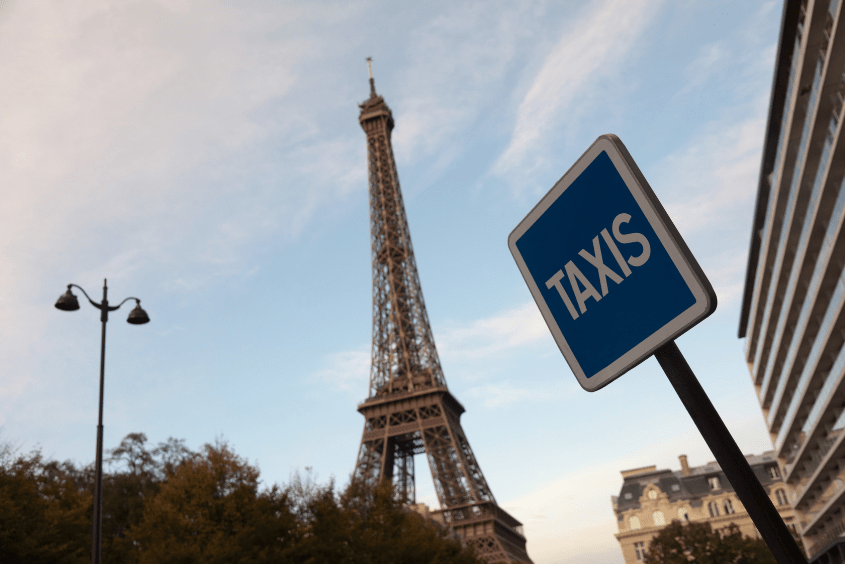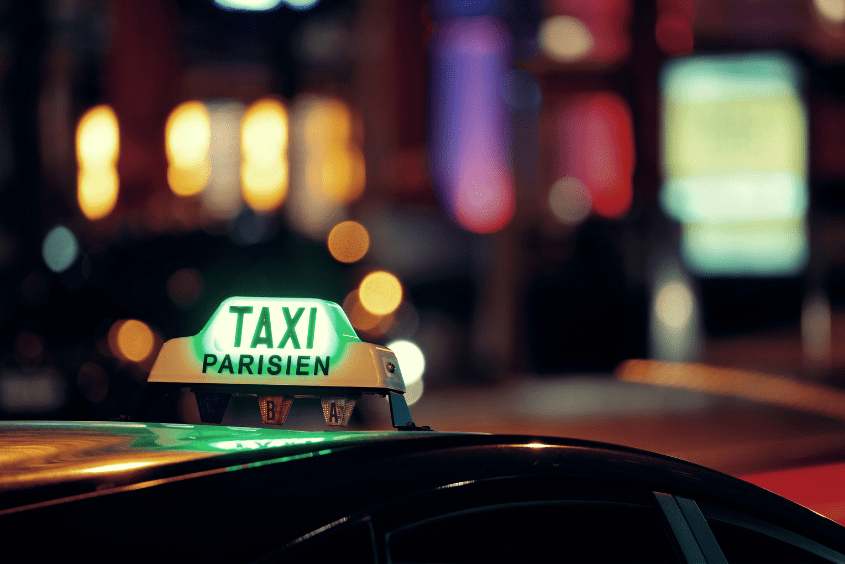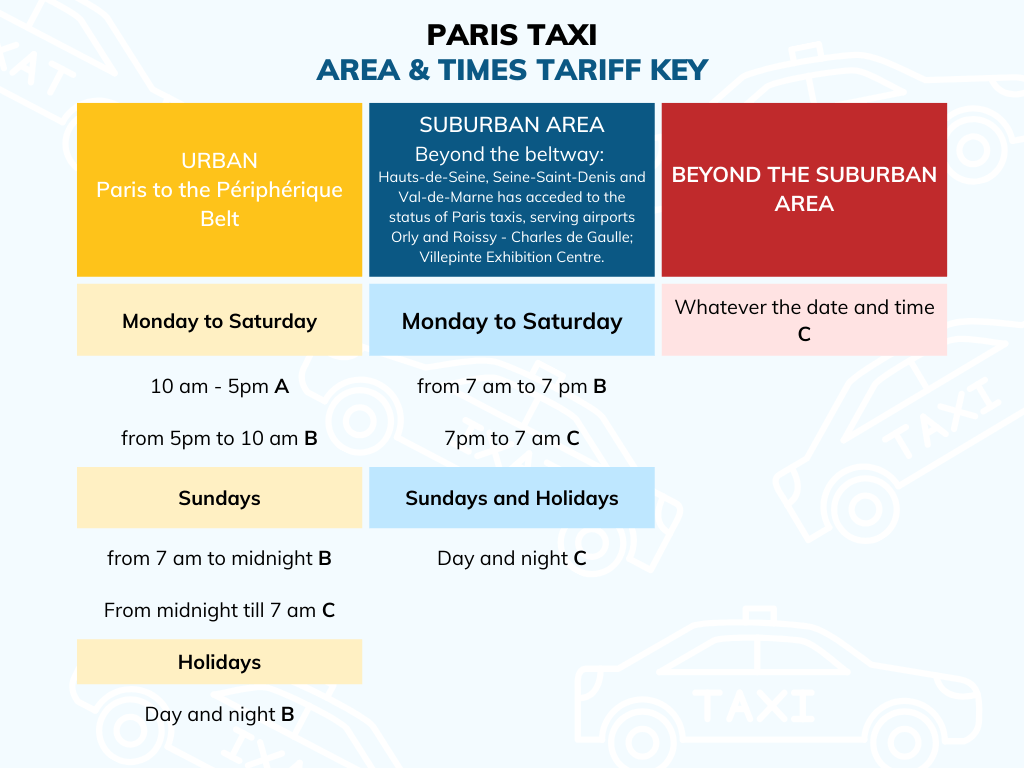
Taking a Taxi in Paris
Updated July 2024 for extra info about the Paris Olympics
Why is it that Paris taxis have such a bad rep? Why is it that you can never seem to get a taxi when you need one? Why is it that they don’t stop when you flag them down? What does a normal taxi look like? What does the taxi cost from point A to B? All these questions come into the minds of tourists when traveling to Paris. Some of these questions are even in the minds of locals who could probably offer their fair share of taxi horror stories but they are not all bad.
Here are a few helpful tips and facts to help make your next Taxi Parisien trip go smoother or at least provide you with peace of mind.
What You’ll See on a Licensed Taxi
- Light globes with three repeaters (small bulbs) setting forth the rates A, B, and C. These are lights on top of the taxi that indicate the fare rate being applied: A, B, or C. These rates vary depending on the time of day and location (e.g., within the city, suburban areas, or nighttime rates). The presence of three small bulbs or repeaters helps passengers identify the current fare rate before entering the taxi.
- An opaque sheath (to cover the light at the end of service).
- Inside the vehicle, a counter horokilométrique (the taximeter) shows the tariff applied. This device calculates the fare based on the distance traveled and the rate in effect. It ensures transparency in pricing for passengers.
- This is a notice inside the taxi, typically affixed to the left rear window. It provides passengers with a summary of the taxi’s regulations, fare rates, and the vehicle’s registration number. This placard is meant to inform passengers and ensure compliance with local taxi regulations.
- A black plaque on the right front fender of the vehicle with the word PARIS number and a parking permit. This plaque displays the word “PARIS,” a unique identification number for the taxi, and a parking permit. It serves as an official marker, identifying the vehicle as a licensed Parisian taxi.

How to recognize when a taxi is free
A taxi is free when the light “taxi” is on (or more recently when the light is green). When off, only the light color indicating the rate in effect will remain lit – this therefore means the taxi is reserved or occupied. When the taxi is no longer in use, its light is covered with an opaque sheath.
Prices for Parisian Taxis 2024
Basic Charges:
- Pick-up Charge (This is the initial fee that is charged as soon as you enter the taxi. It is a standard starting fee that applies to all taxi rides): €4.40
- Minimum Journey Fare: €8 (regardless of distance)
- Supplement per Person from the Fifth Passenger Onwards: €4
Tariffs:
- Tariff A (applies to trips within central Paris, Monday-Saturday, 10 AM – 5 PM):
- Per KM: €1.27
- Per Hour: €41.06
- Tariff B (applies to trips within central Paris, Monday-Saturday, 5 PM – 10 AM, and Sundays):
- Per KM: €1.61
- Per Hour: €50.52
- Tariff C (applies to trips within the suburbs and beyond, Sundays and public holidays):
- Per KM: €1.74
- Per Hour: €42.10
Booking Fees :
(These are additional fees applied when you book a taxi in advance or immediately through a phone call or an app)
- Immediate Booking Fee: €4
- Advance Booking Fee: €7
For trips starting in the outer suburbs, the hourly tariff (A, B, or C) applies from the time the driver starts the journey towards the pick-up location, rather than a flat booking fee.
Tariff Application Times:
Additional Notes
- No Extra Charge for Luggage: Most services do not charge extra for luggage, except for more than one large item.
- Payment Methods: Not all taxis accept credit cards, so it’s advisable to confirm the payment method before starting your journey and have small bills available. The famous G7 Taxis typically do accept card payments.
- The meter automatically applies the hourly rate instead of the kilometer rate when the taxi is stationary or moving slowly.
- The suburban zone includes the Paris taxi zone outside Paris and service to Orly, Roissy CDG, and Villepinte airports.
- For disabled passengers, no extra charge will be made for transporting their wheelchair.

For direct taxi fares between Paris and the airports (Roissy-Charles-de-Gaulle and Orly) in both directions, the fixed rates in 2024 are:
- €56 between Charles-de-Gaulle Airport and Paris’s right bank.
- €65 between Charles-de-Gaulle Airport and Paris’s left bank.
- €44 between Orly Airport and Paris’s right bank.
- €36 between Orly Airport and Paris’s left bank.
Olympic Updates
Traditional taxis in Paris, such as G7, Taxis Bleus, and Alpha Taxis, will continue to have unrestricted access to all areas of the city, including those with special restrictions for other vehicles. This ensures that official taxis remain a reliable option for reaching any destination during the Olympics.
- G7 Taxis: Contact at 01 47 39 47 39 (English service available at +33 1 41 27 66 99)
- Taxis Bleus: Contact at 08 91 70 10 10
- Alpha Taxis: Contact at 01 45 85 85 85 (English service available at +33 1 45 85 00 00)
These services are known for their reliability and regulated pricing, which can often be more economical compared to VTC services during high-demand periods due to dynamic pricing models used by companies like Uber
Additional Insights to be in the know!
If you have a preferred route let the driver know. Maybe you can google map your route ahead of time if you like but most of the drivers will use a route they know or that they think is faster.
Service Refusal
An interesting thing to know about Parisian taxis is that they are not allowed to refuse a course. Now many people reading this line will probably laugh but it is true. A taxi driver risks a fine of up to 1500 euros for refusing a passenger. However do not be surprised if you are refused if you are less than 50 meters from a taxi stand. They can refuse you if you are drunk or if you are with a dog that risks dirtying their car (except guide dogs).
They are also not obligated to take you if they are at the end of their service (time on the back), and your route will take them far from their final destination.
If their registration allows them to take more than 3 people in their car, they are not allowed to refuse you there either. Note that there is a surcharge for the number of passengers over 3. 2 children count as one adult (this I did not know).

Extra Charges
There is a surcharge for any ride starting at a train station or airport.
There is a surcharge for a 2nd bag in the trunk.
Taxi drivers are under the obligation to provide a receipt for any course that is over 25 euros with the date, the time of day the license plate number etc.
Reserving a taxi ahead of time will cost more money because the meter will be running from the time that the taxi is on its way to you. That said, during rush hour, it can put your mind at ease to know that you will have a taxi for you and not have to find the nearest stand or call and discover there are no available taxis in your area.
The Drivers
Now for the most part the taxi drivers are friendly and professional but admittedly there are far too many who are rude and obnoxious and thus give the entire bunch a bad rep. I’ve heard a few scary stories when it comes to taxis but I have also heard a few great ones including drivers going out of their way to return keys that a guest left in their taxi – thank goodness I had my number on there.
To file a complaint against a Parisian taxi contact the Préfecture de police 36 rue des Morillons, 75732 Paris Cedex 15.
Are Taxis Your Only Option?
Sources:
Dossierfamilial.com
taxilib.com
So with all this knowledge in hand, take your taxi ride in stride. For an estimated cost of taxi fares around the world try the World Taxi Meter.



I was seven months pregnant, next in line at the taxi rank, and the driver refused to take me because I was pregnant. The driver behind him heard this exchange, jumped out of his taxi, and kindly offered me a ride. He then informed me that it was illegal to refuse a pregnant woman. I don’t know if that is true or not, but I was sure glad for his kindness.
Wow, your experience really shows the dual nature of Parisian taxi drivers, you can meet the friendliest person in Paris or a real so ‘n so!
The second taxi driver was right, In Paris, taxi drivers are generally not allowed to refuse service to passengers based on personal characteristics like pregnancy. French law prohibits discrimination, and taxi drivers must adhere to this rule. Refusing a pregnant woman solely because she is pregnant could be considered discriminatory and illegal.
However, there might be exceptions in certain situations, such as if the driver genuinely believes that transporting the passenger could pose a risk to safety, for example, if a woman is in advanced labor and the driver feels that immediate medical attention is required, and a taxi may not be the appropriate or safe transport option. In such cases, the driver should assist in finding appropriate help, like calling emergency services.